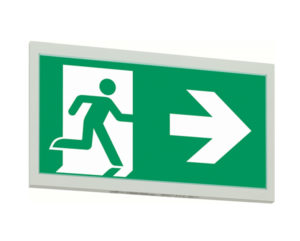What is an emergency exit light? How does it work?
An emergency exit light, also known as an exit sign or green exit sign, serves as a vital safety device during critical situations like electrical failures, power outages, or fires. Its primary purpose is to illuminate evacuation paths to safety, aiding in the swift evacuation of building occupants. This essential piece of emergency and evacuation signage, in compliance with emergency lighting standards, plays a pivotal role in ensuring the safety and well-being of those inside.
So, how do exit signs work?
Emergency exit lighting is a critical part of a building’s safety infrastructure. Designed to guide occupants to the nearest fire exit, these lights provide steady, reliable illumination during power outages or emergencies. By lighting the way clearly, they reduce the risk of trips and falls and help people navigate safely through corridors, stairwells, and open areas. In some cases, they can also assist in locating essential evacuation equipment.
In the event of an emergency, the presence of clear, well-maintained emergency signage, such as fire exit signs and Braille signs, further enhances the effectiveness of the emergency exit lighting. Together, these elements contribute to a safer and more efficient evacuation process, underscoring the importance of emergency lighting and signage in any building.
According to the Building Code of Australia, any storey with more than 300m² of floor space must be equipped with an emergency lighting system. Additionally, any hallway used as an evacuation route or any room larger than 100m² without direct hallway access must also include emergency lighting. Exit signs must be placed above doors, along designated exit paths, and clearly visible at all times.
We offer various emergency and exit lighting products in various sizes and brands. Whether you need new installations, replacements, or components such as globes and covers, our team can help. Get in touch to ensure your building is compliant and your emergency lighting system functions as it should.

What Type Of Exit Light Do I have?
There are two primary categories of emergency exit lights:
- Dual-Function Emergency Exit Lights: These exit lights consist of two bulbs. The first bulb remains illuminated at all times, drawing power from the building’s electrical supply. The second bulb is designed to activate automatically when a power outage occurs, and is powered by a backup power battery. This ensures continuous illumination even in emergencies.
- Emergency-Activated Exit Lights: In contrast, emergency-activated exit lights only come to life when an emergency arises. These lights remain dormant during regular power supply but are constantly charged by the building’s electrical system. They spring into action when needed, providing essential guidance during critical moments.
The A-grade technicians at ACME Test & Tagging can replace any type of malfunctioning emergency and exit lights or handle any other necessary repairs. Contact Us for a Free Quote.

During an emergency exit light test, our technicians complete:
- Inspection of the area to determine compliance with the standards (i.e. visibility, signage)
- Timed battery test
- Inspection of all bulbs, lights, diffusers and batteries (and replacing these, when necessary)
- Cleaning of the light reflecting surfaces to ensure the visibility of the illumination is maximised
- A comprehensive report, outlining the service completed, the date, location, outcomes and recommendations
- Follow-up reminders to notify you when your testing is due again
Why Should I Have My Emergency Exit Light Tested?
When your emergency exit lights operate correctly, you will adhere to Australian standards AS/NZS 2293.2:2019, as well as guarantee the safe egress of individuals from a building and ensure building compliance. Routine assessments conducted by professional service providers such as ACME Test & Tagging ensure that these emergency lights are adequately maintained and in optimal working condition.
Similar to any electrical equipment, emergency lights may experience a decline in quality over time. While they may still activate, there’s a risk that they may not illuminate properly or sustain the required duration.
Our Emergecny Exit Light Testing Process
For compliance testing, emergency exit lights must remain illuminated for a minimum of 90 minutes. During your scheduled service, which includes inspection and annual cleaning, our team of licensed technicians will ensure that the emergency exit lights function as intended and provide adequate illumination and the safety of building occupants.
Our expert advice and professional services encompass emergency lighting installations, emergency light testing, and maintenance of emergency lighting. These essential safety measures, including battery backup systems, address faulty fittings and compliance assessments, guarantee that your commercial buildings meet the legal requirements for the safety of occupants and maintain a well-lit egress path of travel in case of a power failure. Trust our team of licensed technicians to provide comprehensive assessments and ensure your emergency luminaries meet the necessary standards for the safety of all.
